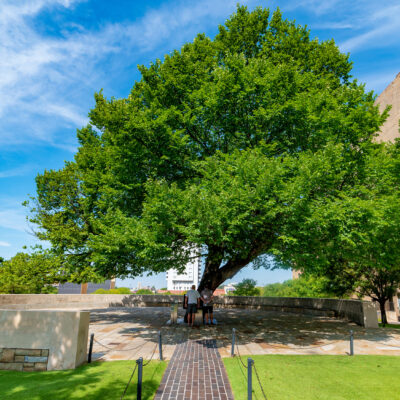Lesson Plan
Cooperation: All Knotted Up
The rescue, recovery, and investigation of the Oklahoma City bombing was an unprecedented event that involved dozens of local, state, and federal agencies. An amazing amount of cooperation and communication had to take place between these agencies in order to reach survivors and solve the crime.
Lesson Summary
Students will view video interviews about cooperation and communication from Oklahoma’s former governor as well as the Federal Emergency Management Agency (FEMA) director who was in office at the time of the bombing. Students will form a “human knot” to simulate communication in times of chaos.
- Essential Questions: What role did communication play during the aftermath of the Oklahoma City bombing? How are cooperation and communication vital to society?
- Time frame: 1-2 class periods
- Subject(s): Social Studies, Oklahoma History, Physical Education
Materials Needed
- Access to the Oklahoma City National Memorial & Museum website
Lesson
- Facilitate a discussion about teamwork using the following prompt: “Teachers and adults seem to talk to kids about teamwork all the time, but when do adults use teamwork? Do the adults you know have to work well with others? Give some examples.”
- Explain that the Oklahoma City bombing had to involve teamwork because it was an unusual type of crime for many reasons:
-
- Because the Alfred P. Murrah Building housed federal agencies, the bombing was a federal crime, meaning state and local investigators would be working side by side with federal officials from outside of Oklahoma.
- While local firefighters and paramedics were searching through the rubble for survivors, the FBI and other agencies were searching for evidence in that same rubble. Crime scenes are usually blocked off and sifted through in a slow and orderly manner, but that was not possible with so many survivors needing immediate help inside the building. In fact, The Oklahoma City bombing was the first incident in U.S. history to be declared both a federal disaster as well as a crime scene.
- Rescue workers from all across the country came to Oklahoma to help with the rescue and recovery efforts. Oklahoma rescue workers learned very quickly to work alongside strangers in order to complete their goals.
- View one or more of the interviews about cooperation and communication during the Oklahoma City bombing rescue and recovery.
- Human knot activity:
-
- Explain to students they will now use cooperation and teamwork to solve a problem.
- Students form a circle.
- Instruct students to reach across the circle and grab the hands of two different people.
- They now have to get themselves out of this human knot and make a circle again, without letting go of the others’ hands.
- When finished, recap the challenges faced during the knot exercise. What were the main challenges? When did you use communication and cooperation the most? What were effective ways of communicating? Did a leader step up to help solve the problem faster?
- Suggested assessments:
-
- Write a paragraph explaining a time in your life that teamwork helped solve a problem.
- Make a list of reasons that teamwork can be difficult, and then provide possible solutions for each item on your list.
- Research the relationship between national, state, and local law enforcement agencies and draw a flow chart or Venn diagram to outline your findings.
Oklahoma Academic Standards for Social Studies; Oklahoma History Content Standard 5:10; grades 9-12:
Cite specific textual and visual evidence to analyze the causes and effects of the domestic terrorist attack on the Murrah Federal Building in Oklahoma City, including the responses of Oklahomans to the event, the concept of the Oklahoma Standard and the creation of the Oklahoma City National Memorial & Museum.
Oklahoma Physical Education Standard 4.M5; grade 6:
Cooperates with a small group of classmates during adventure activities, game play, or team-building activities.
Oklahoma Physical Education Standard 4.M5; grade 7:
Problem solves with a small group of classmates during adventure activities, small-group initiatives, or game play.
Oklahoma Physical Education Standard 4.M5; grade 8:
Cooperates with multiple classmates on problem-solving initiatives, including adventure activities, large group initiative, and game play.
National Council for the Social Studies 6.e; grades 6-12:
Social studies programs should include experiences that provide for the study of how people create and change structures of power, authority, and governance, so that the learner can distinguish among local, state, and national government.
SHAPE America National Standards for Physical Education Standard 4:
The physically literate individual exhibits responsible personal and social behavior that respects self and others.





